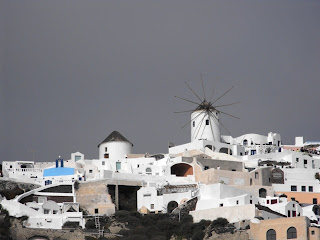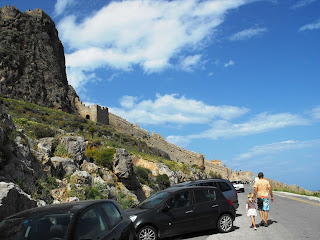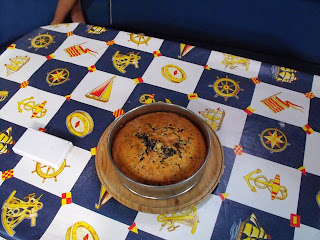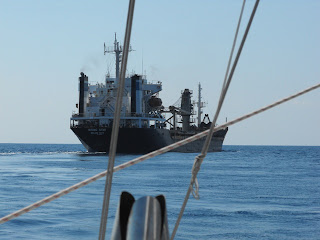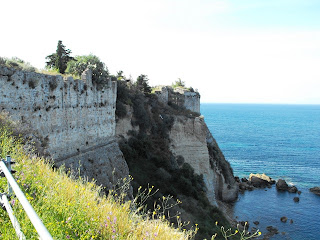Leaving Rhodes, we got a snap of this unusual vessel- a very futuristic looking glass bottom boat- and it could also go quite fast.
The day started calm enough, with enough of a breeze to allow me to fiddle with one of the new toys- the Hydro Vane self steering rudder. It works well enough, but will definately be better in steady Atlantic type winds, compared to the changable meddeteranian stuff. We had a fairly relaxed day, some sailing and some motoring, and got into the island of Tilos to anchor for the night.
Next morning we set off early, and it was quite a different day- overcast and plenty of wind. The wet weather gear was hauled out for the first time in a long time!
We or should I say I, myself enjoyed a brisk down wind sail, while other members of the family were not so impressed.
This was probably the first kind of rough long period of sailing this season, and the girls were taking a bit of time to get used to the motion. Generally they sleep when it gets rough.
Going down wind, the boat tends to roll from side to side, but eventually with a bit of experimenting, I got the small jib boomed out and the mainsail goose-winged, and things steadied up as we raced along.
THERE SHOULD BE A VIDEO HERE BUT IT WONT LET ME PUT ANOTHER IN THIS POST SO I WILL POST IT SEPERATELY NEXT!
Our days trip was over 70 miles and we were very glad to eventually drop our anchor in the almost land locked bay of Vathi in the island of Astipalaia. It had been our windiest day so far, but at least we made good time, logging an average speed for the day of about 6.5 knots, and almost entirely under sail power. Again we planned to leave early, so for the girls that meant breakfast on the move, which they were not so happy about.
There were good reasons for our hurry to move on. Firstly, we have now decided to park up the yacht on the Atlantic coast about the end of June, (for a quick trip home) so there are a lot of miles to cover. Second, the prevailing winds generally blow from the west, so when any easterly winds are forecast we must take full advantage of them.
It was a very murky morning, with no signs of life except for the occasional local fishing boat heading back to port.
The trip from Astipalaia to the next island of Thira was more of a motor sail, but thats how it is in the Med. Thira is a very spectacular island, and popular with tourists and cruise ships. The island as it stands today is the remains of a very large volcano which the sea has breeched and formed a very deep half moon bay. because it is so deep, anchoring is impossible, but we knew this and had information abot mooring bouys which we could tie up to
This photo shows the flat agricultural side of the island...........
And as we came around into the bay, the coast became steeper and more interesting.
The colourfull view is amazing- the brilliant white village on the hill top, the various rock formations all the way down to the sea shore.
A very "Greek" view, white buildings with an occasional splash of blue. ( the windows and doors )
Regarding the mooring, notwithstanding the strong gusts of wind that thunder down the steep cliffs, we managed to get tied up to one of the mooring buoys. However, just as we were relaxing, the owner of the above pictured yacht came over to give us the heart breaking news that we could not stay on that buoy, and in fact there were no free mooring buoys. This was not good news, considering that we had been travelling over 12 hours, and we definitely could not just drop anchor.
We did the only thing we could do and motored dow to the main cruise liner drop off point, and after a bit of hovering about, getting the lay of the land, so to speak, we decided to take a chance and tie up to a very large cruise liner buoy.
Linda did a very daring leap onto the buoy to attatch a rope, and we then took a loop of the heavy three inch shore line............
........which then gave us a very secure mooring.
And best of all, no one complained or asked for money-great!
We then set about a very well appreciated dinner and a cold beer.
Next morning, after school, we set off ashore to explore.
It certainly is a dramatic setting, and a bit of a daunting thought to have to climb up to the town.
However help was at hand in the form of the cable car, thank heavens!!
Its a long way down, and this was only half way up! You can see Islay Mist looking tiny down below!
The island is still an active volcano, and as recently as 1956, a massive earthquake destroyed almost all of the buildings on the island. This means that there are really no original old buildings, so even this spectuclar old clock tower is only a relitave "baby"
In many of the Greek islands, donkeys are still a daily used method of transport.
They are cheap to run, and can climb steps and pass through narrow streets.
The family taking a well earned rest.
A view of the cliff top village.
These are examples of wall frescoes ( paintings) rescued from the ruins of ancient ruins and now installed in the local museum.
As I said before, donkeys rule here, and are in great demand to take the tourists from the cruise liners up the very steep path into town.
The girls thought that they were quite smelly creatures, and the much preferred the cable car option.
I wonder why.................!!!
This is all the harbour consists off, not deep either, and full of "flit" boats , required to ferry the passengers ashore from the cruise liners.
Our mooring at night.
Looking up to town.
A very Greek appartment block, white and blue.
So all good things must come to an end, and we set off again, ever westwards to our next island destination of Milos. Milos is also an ex volcano, with a bay formed in a similar half moon shape, but not so dramatic as Thira. It has far more useable agricultural land, and also boasts a very active open cast mining industry, with quarries and ship loading facilities visible along the coast.
One of the large mining harbours.
The geology and rock formations are very impressive and colourful.
Typically Greek, the village perched on the hill top (chora), from a distance it almost looks like snow.
After a good nights sleep, school next morning and then ashore to have a good long walk and picnic. The agricultural efforts are impressive, given the rocky terrain.
Small fields of barley, with wild flowers in abundance.
Vines for the all important wine industry.
Is there a big bad wolf?- we just had to find out!!!
The island is very beautiful, especially in spring time, when the place is a fountain of colour.
A farmer at work.
A field of oats, fully grown and ready to ripen.
Big wind turbines, which I have to say, did not spoil he view and could not be heard.
More fields of corn.
And another ship loading berth.
What views............
A contraption used in the harvesting of olives.
Then we hit the beach, great fun..........
..........except when you are getting sucked under by sinking sands!!!!
Free again, and back to gathering up special stones.
This poor turtle caused quite a bit of interest. Did he die of starvation, heat, cold or simply old age, who knows?
Then a poor billy goat, which lead to more speculation regarding death!!
Back to the boat with the days haul of special stones and flowers. There are volcanic stones like you have never seen before, and we now have most of them. The boat is heeling to starboard with the weight of them.
And they can be built into little shapes.
Early next morning we set off in very dull conditions, with the optimistic passage plan to sail over 80 miles to round the cape Maleas, historically notorious for being a windy and and difficult route. We actually had a good sail most of the day, but as we got closer to the cape, the wind increased.
As always the direction changed so that we ended up banging away into big waves and on the nose.
We were struggling to make headway and even with the engine on, our lee way was driving us too close to the shore, (it is a bit like Sumburgh head in Shetland ), it was getting late and dark and it is a busy shipping channel so we took the very rare decision to abort the planned route and head for the shelter of the nearest down wind harbour which was still 20+ miles away.
Of course, heading back around the cape, the conditions improved, and we had to motorsail to the harbour of Monemvasia. As it was too dark to enter the harbour, we anchored for the night. but next morning we tied up alongside a good concrete pier, the first alongside berth for many a day and it was free!
We were in good company as you can see!!
Monemvasia is actually the name of the old fortified village which is sited on the other side of the rocky outcrop in the photo behind us. As is common, forts, castles and the like were usually sited on a high rocky outcrop, which more often than not, is actually a "volcanic plug' ie the hard rock lava which is left behind after the soft ash lava has eroded. ( this only take a million or so years )
Anyway, Monemvasia village is unique as it is stiil fairly original, and the rebuilding is more of an ongoing repair, rather than reconstruction after an eartquake or war.
On the way we stopped to admire the small imaculate grave yard.
The village is quite a walk, but as soon as the walls are in sight, you can see how easy it was to construct the defences, as the original natural rock "plug" is so steep.

Inside the walls, the streets are narrow and winding, with many of the buildings now reconstructed for tourist shops and cafe/bars.

The main square and church.

The Christain church tower in the foreground, and the older Turkish Mosque behind.
The buildings are very close together and the maze of steps and paths could lead to loosing your way.
Its a long hike up to the higher level of the town.
A very long way up in fact!!
This is the remains of an old mosque/church/mosque/church, in which you can see the vaulted construction which was universally common.
The same building from the other side.
According to the information board on the site, this building was used as a gun powder store, even up until the second world war!! hard to believe carrying anything up that steep path, but then they do have the good old donkey.!
Looking down on to our marina berth.
More ruins of another old mosque.
Looking down on the old village.
If you look closely, you could see construction methods from different periods in history.
For instance, this lintel was definitely made for finer things, and not just a simple domestic door lintol.
Because space was at a premium, paths were narrow, and as these overhanging steps show, inovative methods were used to make better use of space.
A very rare experience for our family- the famous breakfast fry-up, enjoyed by all.
As we left Monemvasia, we could clearly see the small area that the village site on.

This is a small monestry carved into the cliff face on the point of cape Maleas.
Apparently it is best to give the monks a bit of a wave as you pass by, it gets you some good luck.

There is a lot of shipping rounding the cape, boats going in all directions.
It was a fine day and easy sailing so boredom set in. To win a bet, I endeavoured to tie a bowline using only my feet- and I won!!
This poor soul did not make it round the cape!
We decided to head south to the island of Kithera, and to the harbour of Avelomona, which is described as a sweet little place. It certainly was little, and although we got ourselves squeezed in for the night, we had to leave next day when the wind picked up again.
That evening we did meet up with an English / Dutch family, and the girls enjoyed the company of the young girl Ninky.
Next day we were out in the bay anchored, and after the daily routine of breakfast, school, etc, we decided on a baking session. Linda and the girls baked bread, which we jokingly referred to as "Poo Bread", but when baked we then renamed "Brick bread"
To ease the baking crisis, we brought out a packet mix fruit cake, which usually turns out ok.
The next day, the wind was forecasted to ease down and go a little bit easterly, so we headed south around Kithera, and then north to Koroni, yet another 70 + mile slog. Sadly and predictably, we never got much of the easterly wind, and ended up motor sailing most of the way.
There were some interesting manuvoures on the way to brighten up an otherwise uneventful day. This guy for instance,changed course when he overtook us, simply it would seem to give us a bit of wash.
We anchored in Koroni harbour late at night in the black dark, wondering why we could not see the red port navigation light at the end of the breakwater. next morning we could see why - there is not much left of the structure and no light at-all. I suppose given the Greek economic melt down, its no wonder if a few lights stop working.
The village of Koroni is a beautifull little place, again being spring, flowers everywhere....
and narrow streets...........
.......and exceptionally good value excellent food. This meal, including drinks cost only about 30 euros.!!
The cat waiting for its share..
You never have to look far to see the relics of the previous occupants and their mosques.
We set off to look at the fortress, as if we have not seen enough of them!
Its always interesting though, and of course good excerise.
This was a huge fort in its day, but..........
..........bits have fallen into the sea.
An underground store, in immaculate condition...
...and a gun emplacement.
The Venetians built this fort to protect their sea trading routes, and at their peak, the Venetians were the main traders in the eastern Mediterranean, but needed safe havens for their ships, hence Venetian built forts all over the place.
The obligatory war memorial.
More churches.
And as we left in daylight, you could see how big the fort would have been.
Sailing through the sound between the island of Sapientza and Methoni, we could see more remains of fortifications, again originally Venetian, but as usual with Turkish additions.
Our trip has hammered home one bit of history, and that is that the whole Mediterranean population seems to have fought with each other more or less all the time.
Sadly, on our evening sailing, we often could hear what we imagined would be jet fighters heading down to fire off a few bombs in Libya, so nothing has changed !!
For once we got a lovely sail, down wind with the genniker- easy sailing.
Entering the enclosed bay of Navarinou, we passed the specacular headland complete with arch.
On the 6th of Jly, 1827, the bay of Navarinou was the scene of a "bloody and destructive" sea battle between the british navy and the Turkish- Egyptian fleet, which the very much smaller British fleet won and effectivly set Greece on its path to freedom.
Inside the bay, lies the village of Pilos, with its unfinished marina. This "unfinished " situation is common in Greece, but no-one complains as the berthing is usually free.
We only stayed one night here, as we got a favourable forecast to head over to Sicily. During the evening as I wandered around the harbour, talking to anyone who would listen, I chatted with a couple,commenting that their yacht looked familiar, asked them if they had been far in their boat, that sort of thing.
At 05.30 next morning as we quietly left the harbour, I was very nearly sick when I realised that the guy who I had been chatting to was none other than the famous Rod Heikell, or "Rod the God" as he is more well known as.
For the uninitiated, Rod Heikell has written almost all the pilot books for the entire Mediterranean.
All in all, I thought that it was a very fitting way to leave Greek waters and head west.
Next blog- very soon............








































